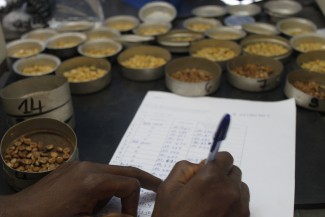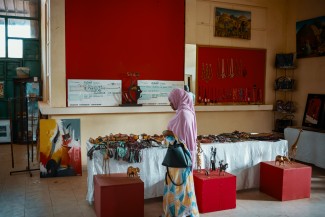New tool offers actions to tackle the barriers to trade that women face
|
|
|
The World Trade Organization’s (WTO) Trade Facilitation Agreement (TFA) is a commitment by WTO members to reduce “red tape” in moving goods across borders. By simplifying and modernizing trade procedures, costs can be reduced by an average of 14.3%, resulting in an annual opportunity to boost trade by up to US$1 trillion.
As trade costs are higher in low-income countries, full implementation of the TFA has the potential to benefit developing and least developed countries the most. However, governments have to take particular action to ensure that these benefits accrue not just to men and large companies, but to women and small business owners, who are often underrepresented in formal trade.
This is because trade reform does not have gender neutral effects. In most societies, women entrepreneurs face unique challenges to growing their businesses and engaging in trade. If policymakers do not identify these barriers and address them, women will not have an equal chance to trade. This is a missed opportunity for communities and economies, as successful women-led firms generate employment and spending on health and education in the community.
A new tool from the Global Alliance for Trade Facilitation helps implementers of trade facilitation initiatives take gender sensitive actions. The tool analyses the TFA from a gender perspective; it looks at the unique challenges women face in trade and explores how implementation of the TFA can mitigate them. Furthermore, it proposes specific actions that implementing governments and development practitioners can take to start addressing these challenges.
Confronting obstacles
Two of the main barriers that women face are accessing relevant information and navigating complex and costly import and export procedures. Trading across borders requires locating a plethora of information about processes, necessary documentation, taxation and transport costs that are spread across different platforms, offices and jurisdictions. There are also high fixed and variable costs to trade that are not always easily visible. In addition, paper-based trading can require a lot of time to physically fill in and deliver documents.
Women who trade across land borders are particularly vulnerable to harassment or extortion from border agents or fraud by clearing and logistics service providers who are primarily male.
While these challenges afflict all businesses, women are disproportionately impacted for several reasons. First, women have greater limits on their time and mobility relative to men due to their dual responsibilities in the workplace and the home. Their mobility can also be limited by cultural norms. Second, women entrepreneurs are more likely to own small-and-medium sized enterprises (SMEs), and therefore have limited human and financial resources to spend locating information and assessing trading opportunities. In addition, women are at a disadvantage to men in situations where they may not have received equal education or skills development opportunities.
Regarding ICT skills, women experience a digital divide that can make them less savvy or confident to navigate trade procedures and information that is increasingly found online. For example, women lag behind men in mobile ownership and internet use across developing countries. A 2017 study from the International Telecommunications Union found that in almost all regions women lag behind men in internet penetration, with the problem most pronounced in least developed countries where only 14.1% of women use the internet compared to 21% of men. Furthermore, the Mobile Gender Gap Report found an 8% gender gap in mobile ownership in low-and-middle income countries in 2019, which is most pronounced in South Asia at 23%. For these reasons, women face disproportionate challenges to accessing information and procedures necessary to trade.
Representation matters
Another barrier faced by women is limited female representation in national customs and trade facilitation agencies, as well as in key trading services such as customs brokers. Thus, laws are often crafted without a female perspective, creating unintended barriers for women-owned businesses.
Furthermore, border agents or private sector service providers can take advantage of women by asking for bribes or refusing to openly give information. Women who trade across land borders are particularly vulnerable to harassment or extortion from border agents or fraud by clearing and logistics service providers who are primarily male. This acts as a disincentive for women to participate in trade. It is also connected to the access to information problem, as women are more likely to be subjected to this treatment if they cannot locate the accurate rules, regulations and information that specify their rights.
Points of action
The TFA provides an opportunity to remedy these challenges. The ‘TFA through a gender lens’ tool shows that several articles in the TFA can address these gendered barriers. For example, implementers can ensure that information systems are not only made available through the internet, as suggested in Article 1, but designed in a way that makes it easier for women to navigate them. This could mean making information available through different platforms and in multiple languages, or providing ICT training for women entrepreneurs to bridge the digital divide.
The WTO forecasts that full implementation of the TFA represents an opportunity for developing countries to increase exports by up to US0 billion per year. To ensure that this growth is inclusive and sustainable, policymakers should focus on deriving benefits for women-owned firms.
Moreover, gender sensitive implementation of Article 2 could ensure that female stakeholders are consulted on trade policy. Gender sensitive implementation of Article 10.6 can tackle the lack of female representation in the customs broker industry. For example, the Global Alliance for Trade Facilitation projects in Zambia and Malawi will introduce a new licensing framework for customs clearing agents. These projects seek to attract women to the customs broker industry through allocating scholarship funds for female applicants and making trainings available through online platforms that can be completed at flexible times and locations. This should reduce harassment and extortion faced by women who trade across borders.
The WTO forecasts that full implementation of the TFA represents an opportunity for developing countries to increase exports by up to US$730 billion per year. To ensure that this growth is inclusive and sustainable, policymakers should focus on deriving benefits for women-owned firms. A gender sensitive implementation of the TFA will help to remove the barriers to trade faced by all genders, thereby benefiting national economic growth and community welfare.
Help drive a gender sensitive implementation of the TFA by reviewing and sharing the tool today with government, trade practitioners and business associations.
Header image of emergency food supplies being delivered in the Philippines - ©Eric Sale/Asian Development Bank via Flickr Creative Commons Attribution-NonCommercial-NoDerivs 2.0 Generic (CC BY-NC-ND 2.0) license.
If you would like to reuse any material published here, please let us know by sending an email to EIF Communications: eifcommunications@wto.org.



